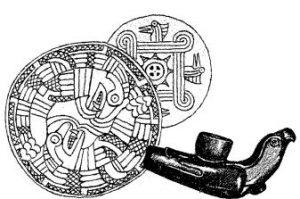 Clues to the earliest inhabitants of the area now known as Indian Hill (northeastern Hamilton County) come from archaeology. When the remains of mounds and surface sites are examined, the story of past human cultures emerges. Native Americans, who predated the Shawnee tribes who once hunted on Indian Hill, were present in this area from prehistoric times (c. 7000-2000 B.C.) until about 1625.
Clues to the earliest inhabitants of the area now known as Indian Hill (northeastern Hamilton County) come from archaeology. When the remains of mounds and surface sites are examined, the story of past human cultures emerges. Native Americans, who predated the Shawnee tribes who once hunted on Indian Hill, were present in this area from prehistoric times (c. 7000-2000 B.C.) until about 1625.
Dr. Charles Metz (1847-1926), a Madisonville physician, proved the existence of Mound Builders in southwestern Ohio. He became interested in the earthworks he observed on his horseback trips to see patients in surrounding hamlets. Locals gave him tips about a pottery field in present day Mariemont, where he unearthed bones and vessels. Forming the Literary and Scientific Society of Madisonville, Metz and other men excavated and surveyed various sites. They developed a Chart of the Prehistoric Monuments of the Little Miami Valley, plotting local sites discovered in the 1870’s and ’80’s. The Cincinnati Society of Natural History offered support, with the understanding that the excavators would donate some artifacts. These weekend archaeologists published their findings, attracting the attention of Dr. Putnam of Harvard’s Peabody Museum; and in 1881 this museum began to fund excavations at the “Madisonville site” (now Mariemont.)
 The records of the Madisonville Society, while not as precise as modern-day excavators, list thousands of artifacts and the location of many sites. By 1911 “Madisonville” alone yielded 1200 human burials and more than 1000 storage pits. These sites yielded the remains of Native Americans and their culture: tools, vessels, and religious effigies. Wooden implements had decayed, but bone and stone remnants were salvaged, including axes, ceramic jars, arrow shaft wrenches (used to straighten arrows,) armbands, harpoon heads of antler, spades, scrapers, flint knives, along with pipes, bone rasps, and bird bone flutes. There is at the Cincinnati Museum of Natural History a prehistoric grooved axe head (c. 2000 B.C.) found in Indian Hill.
The records of the Madisonville Society, while not as precise as modern-day excavators, list thousands of artifacts and the location of many sites. By 1911 “Madisonville” alone yielded 1200 human burials and more than 1000 storage pits. These sites yielded the remains of Native Americans and their culture: tools, vessels, and religious effigies. Wooden implements had decayed, but bone and stone remnants were salvaged, including axes, ceramic jars, arrow shaft wrenches (used to straighten arrows,) armbands, harpoon heads of antler, spades, scrapers, flint knives, along with pipes, bone rasps, and bird bone flutes. There is at the Cincinnati Museum of Natural History a prehistoric grooved axe head (c. 2000 B.C.) found in Indian Hill.
In 1878 Dr. Metz documented a pair of Indian mounds on Drake Road near Armstrong Chapel, describing each as “a circular embankment, about three feet high and about 400 feet in circumference, enclosing a tumulus about four feet high.” A cluster of sites were also found near where Indian Hill Road descends to Terrace Park. Legend recalls a large mound at the end of Walton Creek Road. Flint flakes and other remains have been found on Remington Road, and a burial site was located on the east side of Miami Road. Many earthworks once visible have been destroyed or altered to make way for roads, farmers’ fields, or houses and barns. Sometimes artifacts were removed from sites by amateurs who never registered their findings. A 1958 Hamilton County survey listed 295 known prehistoric sites, of which half were excavated or destroyed – a permanent loss to archaeological research.
 While the current settlement of Indian Hill has lasted for only circa 200 years, Native Americans walked this area for over 11,000 years. Artifacts left behind by these prehistoric humans document a vanished way of life – a part of the legacy of this geographical area.
While the current settlement of Indian Hill has lasted for only circa 200 years, Native Americans walked this area for over 11,000 years. Artifacts left behind by these prehistoric humans document a vanished way of life – a part of the legacy of this geographical area.
